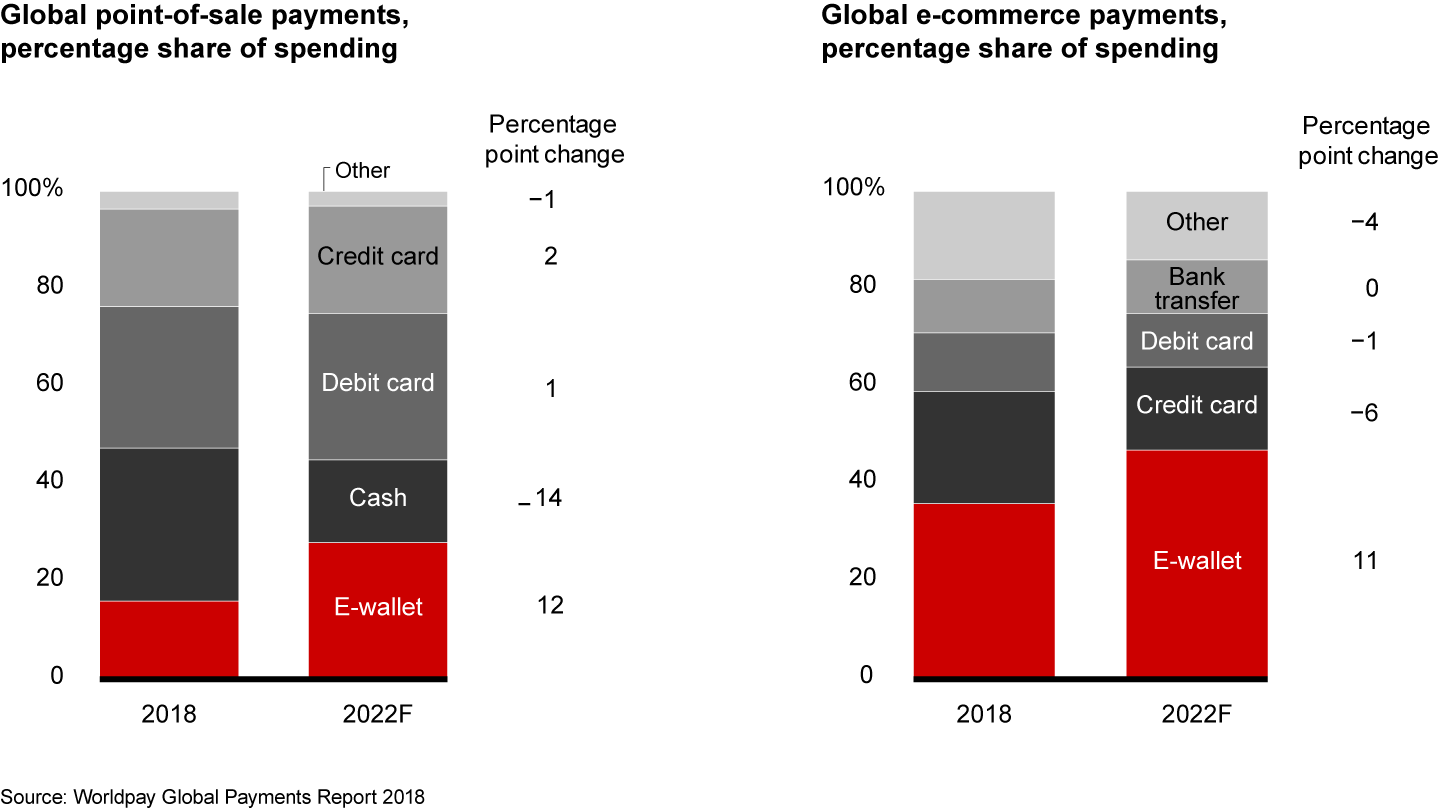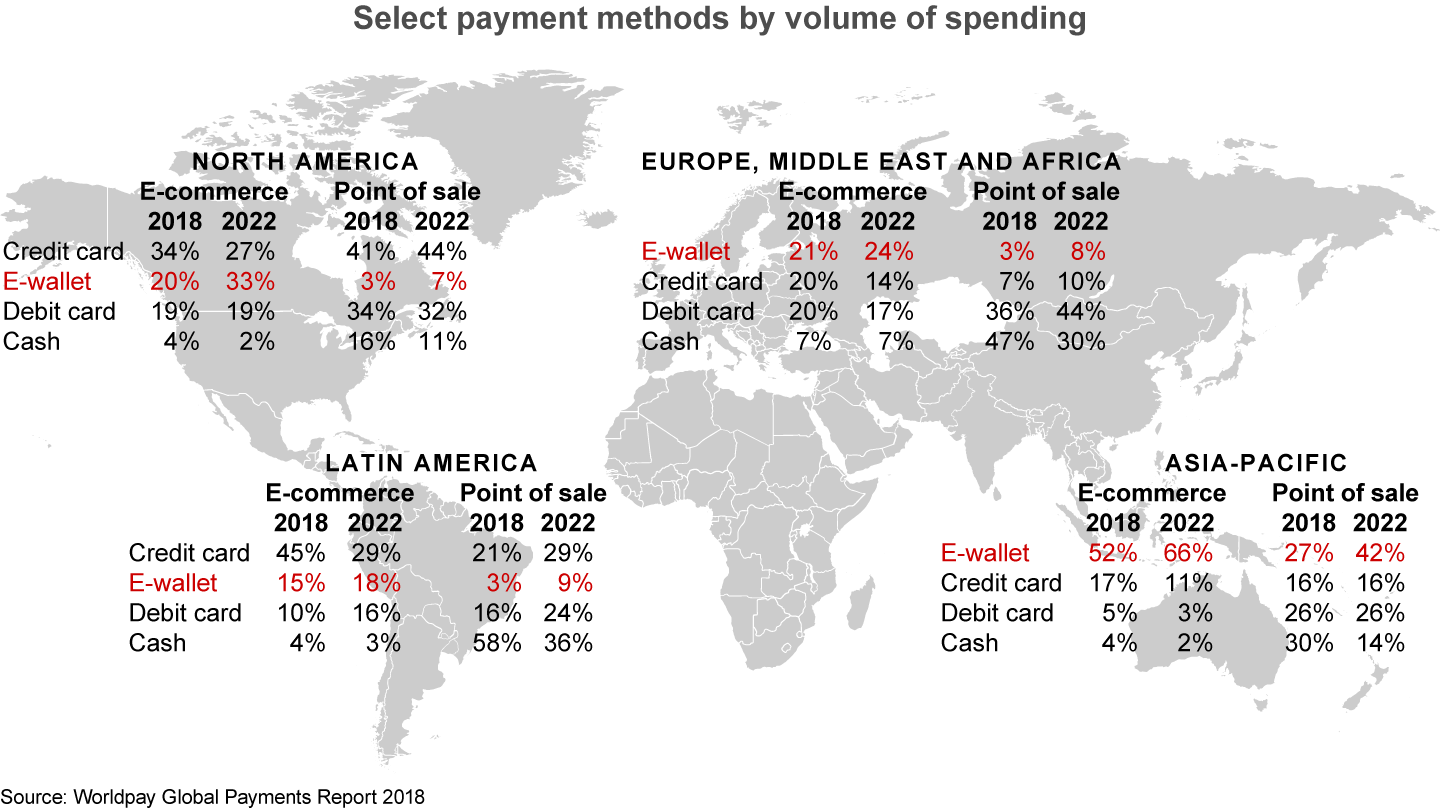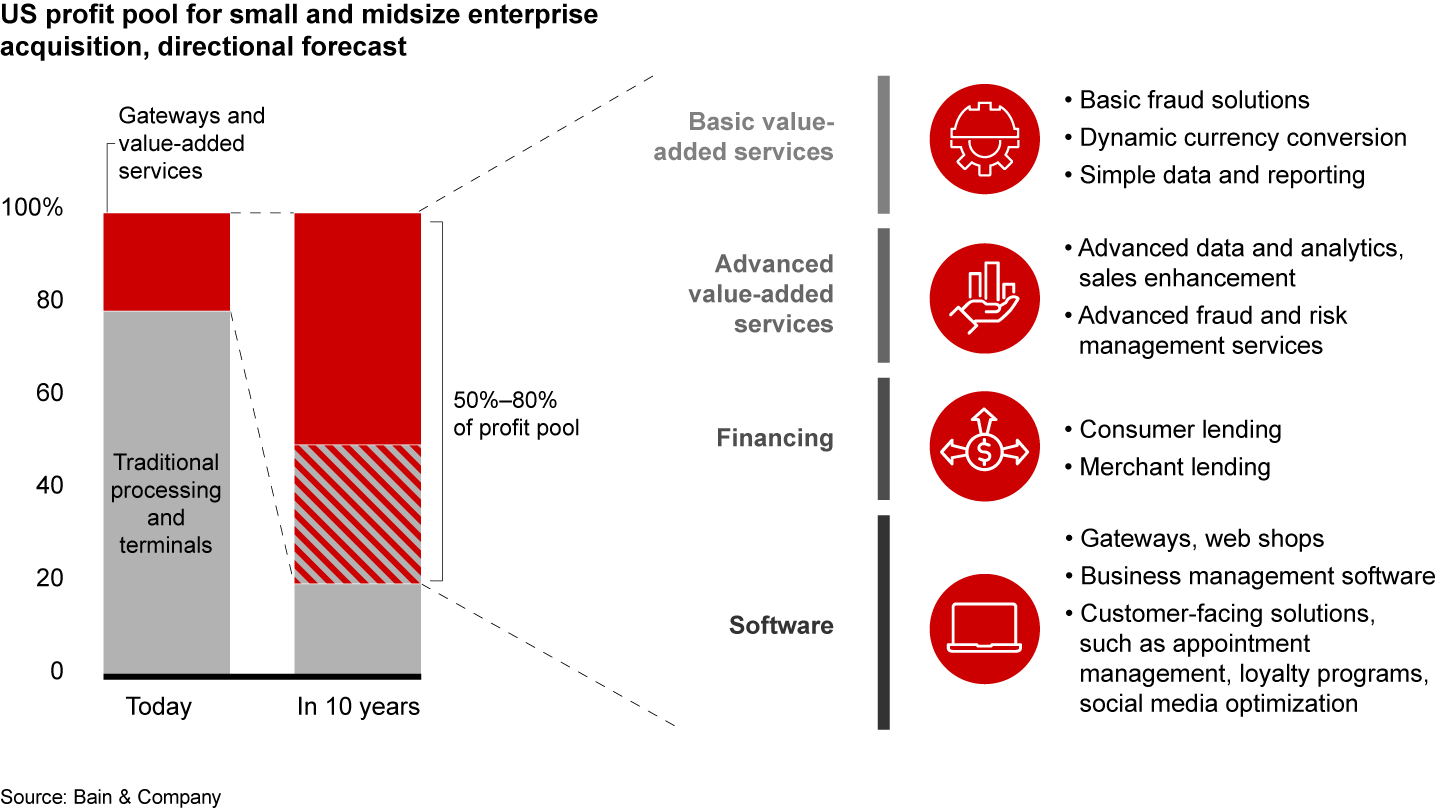Brief

At a Glance
- The nature of payments is changing quickly with technology advances and the rise of e-wallets.
- The payments function increasingly is embedded as just one feature among many—for example, in a mobile app—where the core value and profit derive from other services.
- This phenomenon has accelerated the most in Asia, where consumers have leapfrogged over card payments to adopt e-wallets, notably in super-apps such as WeChat.
- Banks, card companies, retailers, telecommunications firms and technology firms all should assess what role payments will play in their proposition to merchants or consumers.
How the stodgy world of payments has changed. At a recent rugby match in Malaysia, one of the authors ordered grilled satay chicken from a stand run by a 12-year-old boy. Cash only? Hardly—he had a QR code for customers to pay through their Grab app.
Once dominated by big-dog banks and credit card companies, payments are becoming a wagging tail appended to other services offered by any number of digital native companies. As payments competition intensifies and technology reduces costs, the price of payments will continue to go down. In both consumer and business markets, providers increasingly embed the payments function within broader business models and ecosystems.
Almost half of e-commerce payments and more than one-quarter of point-of-sale payments globally will be made via e-wallet by 2022, Worldpay forecasts, largely at the expense of cash, cards and checks (see Figure 1). E-commerce itself will grow at a healthy 19% combined annual growth rate.


In parts of Asia, payments could soon be instant and essentially free to the consumer or merchant. The monetary authorities of Singapore, the Philippines and Thailand envision that situation even for cross-border payments. In India, the early successes of the “India Stack” unified software platform and the Unified Payment Interface (UPI) real-time payment system are being studied by other governments as a potential model to make national payment systems more accessible and efficient. The Indian government is also considering abolishing the “merchant discount rate” charges on merchants who allow their customers to make payments through “low-cost digital payment modes.”
Some mobile apps, such as GrabPay, already offer payments solutions to both consumers and retailers for nothing, using payments as a tool for rapid customer acquisition and leveraging the data to monetize other services. Even in mature card markets where payments remains profitable for banks, merchant acquirers and gateway or payment service providers, including the US, parts of Europe, Brazil and Australia, profits from standalone payments are under pressure and pricing will inevitably decline.
Another threat to the old guard of finance is virtual currency, such as the Libra currency recently proposed by Facebook with the backing of payments networks Visa and Mastercard and Internet companies Uber and eBay. Facebook would embed a payment system into its messaging services, so that users could easily and cheaply send money to friends or make purchases. Libra members argue this would benefit the many people who do not have a bank account by, for instance, slashing the fees on cross-border remittances. To be sure, digital currencies face significant regulatory and technical obstacles before they replace traditional consumer, business and institutional payment workflows. However, the level and sophistication of investment has risen with other initiatives as well, such as JPMorgan’s JPM Coin, digital fiat currency trials by central banks in Singapore, Canada and other countries, and various stablecoin initiatives (designed to minimize volatility or approximate fiat currency) led by multiple banks.
While domestic transactions form the largest category of payments, cross-border payments are the most profitable for banks and credit card networks like Visa and Mastercard, and the ongoing digital evolution threatens this major source of profits (see Figure 2). One bank in Europe, for instance, made nearly one-tenth of its 2016 global profit from money transfers across borders. TransferWise, which charges a fraction of typical bank fees for payment abroad, recently was valued at $3.5 billion after a new investment round, making it one of Europe’s most valuable financial technology start-ups.


Rise of the super-app in Asia
Asia provides the most interesting examples of advanced digital payment methods. Because traditional payment solutions had not yet been fully developed and adopted in India, China and other countries in the region, merchants and consumers leapfrogged to nascent mobile phone offerings. Providers have been using payments to build out broader ecosystems as users increasingly adopt super-apps (see Figure 3).


In Southeast Asia, Grab and Go-Jek, which both began in on-demand ride hailing, are building multi-function apps including payments, to increase customer stickiness. Singapore-based Grab offers food delivery, hotel booking, video, ticketing and travel. Go-Jek, based in Indonesia, has built a suite of services around its core two-wheeler transport, including food and parcel delivery, ticketing, moving and cleaning.
China’s WeChat, an app that began life as a messaging service, has become a one-stop solution for gaming, payments, social commerce, publishing and other features. In India, the Truecaller app that helps users screen strangers and robocallers now includes mobile payments; e-commerce retailer Flipkart runs a mobile payments service based on the UPI; and Amazon offers payment features such as the ability to pay phone bills and cable subscriptions. To remain competitive, banks in the region have been partnering with super-apps; DBS allied with Go-Jek in Singapore, while UOB is the preferred partner of Grab.
These types of firms generally operate under the assumption that eventually they will charge only a small amount—or even nothing—to the end consumer or merchant for payments. Some are burning cash to acquire market positions, with the profitable pieces to come from other functions, such as financing and other financial services to consumers and merchants, as well as a broad range of other services, including accounting and inventory management software. They also develop payments functionality as a way to improve the customer experience on nonfinancial transactions.
The pace at which payments evolves varies greatly by country and region, depending on regulation, culture and customs (see Figure 4). US customers, for example, still have a substantial, though declining, usage of paper checks and a rising usage of credit cards tied to loyalty programs. Germans are known as heavy users of cash, as they are more reticent to borrow through cards. Sweden, by contrast, has become a nearly cashless society. In the UK and Australia, use of contactless “tap and pay” cards has soared in the past four years.


How payments companies are responding
To be sure, many payments companies such as Worldpay, JPMorgan Chase and Bank of America enjoy strong profitability in payments, especially through point-of-sale terminal rentals and transaction processing fees to small and midsize enterprises (SMEs). However, although the volume of transactions continues to expand, the profit pool is slowing. In mature card markets serving large corporate enterprises, which have more leverage with vendors, prices have long since declined. WorldCom forecasts European profits on terminals will decline 8% annually from year-end 2018 through 2022. In sum, even mature card markets are seeing the slow commoditization of traditional consumer-to-business payments.
This doesn’t mean that payments companies cannot continue to earn attractive margins—but it will require changing the playbook. Some are consolidating through mergers and acquisitions, in order to become more efficient in processing and innovation, enter new geographies or business segments, and expand their opportunities for cross selling. Fintech M&A value soared during the first five months of 2019, with $117 billion in activity, the majority being in payment deals, more than the previous three years combined, according to Dealogic.
Besides consolidation, many merchant acquirers have added services beyond traditional terminals and transaction processing, such as lending to merchants and consumers, and business management software that includes payroll, inventory and customer relationship management (see Figure 5). Square, for instance, started as a company offering payments to micromerchants through a small device that connected to a smartphone. Over the past few years, Square has branched out with small business management software and lending to the extent that subscriptions will reach 27% of its revenue by 2020, Barclays estimates.


The third broad strategy involves facilitating e-commerce transactions and integrating payments with the store register. Digital native companies specializing in cross-border e-commerce, such as Adyen and Checkout.com, have seen substantial revenue growth and high valuation multiples accorded by investors.
Making life easier for merchants
Indeed, for many companies offering payments, it’s all about the merchant. Some payments providers, such as Moka in Indonesia, offer rail-agnostic payment solutions to merchants. In other cases, providers have broadened beyond payments. PagSeguro, a business in Brazil targeting small merchants, offers not just point-of-sale and online payment solutions, but also credit plans and sales management systems, and it allows merchants to receive, manage, spend and transfer funds with no need for a traditional bank. Jio, an Indian telecom firm that is part of Reliance, gives small retailers a mobile point-of-sale device with a SIM card to receive payments, inventory and ordering systems.
Many traditional payment schemes have also been investing to evolve their proposition to customers, upgrading the underlying network and opening up their ecosystem. That was part of the rationale for American Express buying Resy, a restaurant table-booking company.
Another big opportunity for merchant acquirers and payment companies is to provide their clients with insights derived from analyzing the underlying transaction data. For instance, acquirers with a major share of transactions can see which cities are doing well for particular product lines and thus should be considered for a retailer’s expansion.
Besides these marketplace changes, new regulation continues to intensify competition in payments. Open banking regulation in Europe, and increasingly in other parts of the world, is prying open payments networks to nonbanks, which allows customers to readily share their financial information with other providers. Dutch payments platform Adyen, for instance, has plugged into the UK’s networks to handle the payment flow between bank and merchant. In some markets, competitive intensity rather than regulatory change has fostered open banking, which could potentially create new payments use cases.
In addition, European Union regulations cap interchange fees at 0.2% of consumer debit cards and 0.3% of credit cards (with caps also in place in countries such as Australia and Brazil for certain card types), affecting the issuers’ profit pool and making it more challenging to fund loyalty schemes.
The pace and magnitude of the change means a standalone payments provider might not create enough value unless it becomes a platform, or a provider to a platform, to offer broader solutions to customers. Incumbent banks and payments providers need to evolve to become true business partners with their clients—helping merchants to sell more, reduce costs and create better experiences for consumers.
Retailers also need to figure out how payments fit into their propositions, by answering a number of questions: What is the role of payments in our business? Should we offer our own mobile wallet or app? If so, should we adopt a closed model or one that can be used with other retailers? How can we integrate our loyalty scheme, or personalized marketing offers, to encourage adoption? Indeed, in North America, some retailer payments solutions, such as Starbucks’ app and Walmart Pay, have adoption rates that exceed those of the global payment solutions (such as Apple Pay), adding value for consumers through services such as advance orders.
Choices now for payments’ future role
No matter what type of company enters the fray, the new proposition tends to focus on value-added services at either end of the payment value chain: convenience and low cost for consumers; and integrated solutions and financing for merchants. Like the future of telephone calls (free and embedded in smartphone apps such as WhatsApp) and automobiles (electric and autonomous), the future view of payments is increasingly clear. Payments will move toward becoming free for consumers and, ultimately, retailers, by being instant and embedded in other services or products. Cars and refrigerators, rather than people, might start making automated refill orders. In the US, Walmart now offers mobile wallet payment at checkout, as does Shell at its gas stations. Juniper Research projects that retail spending using “just walk out” smart checkout technology will grow from $253 million in 2018 to more than $45 billion in transactions by 2023, largely in convenience and general stores. Soon enough, we believe, a critical mass of consumers will demand automatic, “just walk out” payments at most places they shop, so that feature will become table stakes for retailers.
Less clear is how technology platform providers, retailers, e-commerce platforms, banks and governments should navigate the path from here to there. Figuring out the role payments will play in a company’s plans entails developing a view of the future and the structural factors that will shape payments in the near and medium term. Having a future-back view will influence the choices they face now and over time.
Banks will need to decide which of their current profit pools they cede in order to stay relevant in the future payment world. They will also have to evaluate technology choices for modernizing payment capabilities. Merchant acquirers will need to evolve beyond just card processing into alternative payments and new revenue streams. Platforms will increasingly build out consumer and merchant bases using payments, and they will monetize through financing and other services. A retailer may choose to simply embed third-party payments capabilities in its offering, while a large tech company may choose to develop its own standalone payment capability to enable new propositions. The costs of payments infrastructure will continue to be covered, but some, such as national real-time payments systems, will become utility-like while others will be able to charge premiums for solutions, such as fraud prevention.
So many aspects of payments are changing so fast that it would be easy to wait for developments to affect one’s own organization. That would be a mistake. It’s essential to define clear choices that are consistent with the future view of the industry, but also understand which changes will happen soon and will have a substantial effect on the business, and then act on those first. Other changes that could have a big effect over the long run, but are more uncertain, can be monitored for the right time to take action. Further, payment technology, regulation and behavior are evolving quickly, and companies will need to adjust their approach just as quickly.
Where possible, companies should seek to shape the evolution of the market and not just adjust to it. As with most disruptions, some companies will win and others will lose, but the ultimate beneficiaries will be the end users and merchants that demand easy, invisible, instant and costless experiences when paying for things they need.
Thomas Olsen, Glen Williams, Antonio Cerqueiro and Florian Hoppe are partners in Bain & Company’s Financial Services, Digital, TMT and Strategy practices. They are based, respectively, in Singapore, London, São Paulo and Singapore.